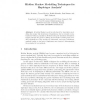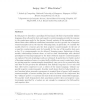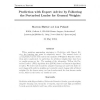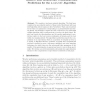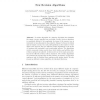104
Voted
ALT
2004
Springer
15 years 9 months ago
2004
Springer
Different formal learning models address different aspects of learning. Below we compare learning via queries—interpreting learning as a one-shot process in which the learner i...
97
Voted
ALT
2004
Springer
15 years 9 months ago
2004
Springer
Abstract. A hidden Markov model is introduced for descriptive modelling the mosaic–like structures of haplotypes, due to iterated recombinations within a population. Methods usin...
ALT
2004
Springer
15 years 9 months ago
2004
Springer
In this paper we introduce a paradigm for learning in the limit of potentially infinite languages from all positive data and negative counterexamples provided in response to the ...
109
Voted
ALT
2004
Springer
15 years 9 months ago
2004
Springer
When applying aggregating strategies to Prediction with Expert Advice, the learning rate must be adaptively tuned. The natural choice of complexity/current loss renders the analys...
69
Voted
ALT
2004
Springer
15 years 9 months ago
2004
Springer
103
Voted
ALT
2004
Springer
15 years 9 months ago
2004
Springer
We consider a two-layer network algorithm. The first layer consists of an uncountable number of linear units. Each linear unit is an LMS algorithm whose inputs are first “kerne...
102
Voted
ALT
2004
Springer
15 years 9 months ago
2004
Springer
We investigate further improvement of boosting in the case that the target concept belongs to the class of r-of-k threshold Boolean functions, which answer “+1” if at least r o...
102
click to vote
ALT
2004
Springer
15 years 9 months ago
2004
Springer
A revision algorithm is a learning algorithm that identifies the target concept, starting from an initial concept. Such an algorithm is considered efficient if its complexity (in ...
114
Voted
ALT
2004
Springer
15 years 9 months ago
2004
Springer
Kernel functions are typically viewed as providing an implicit mapping of points into a high-dimensional space, with the ability to gain much of the power of that space without inc...
83
Voted
ALT
2004
Springer
15 years 9 months ago
2004
Springer

